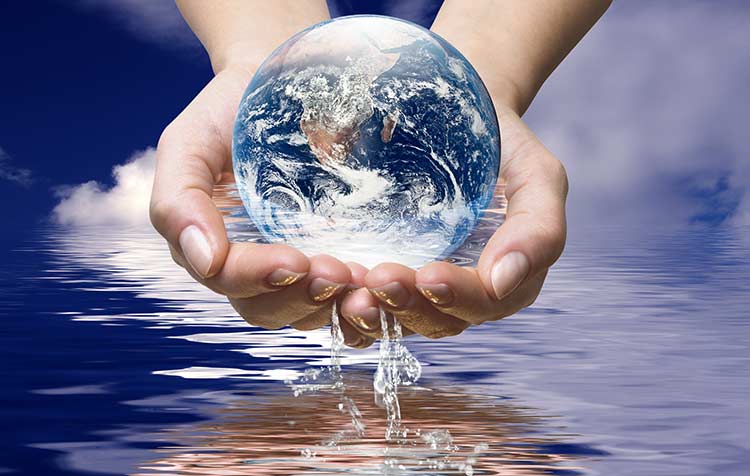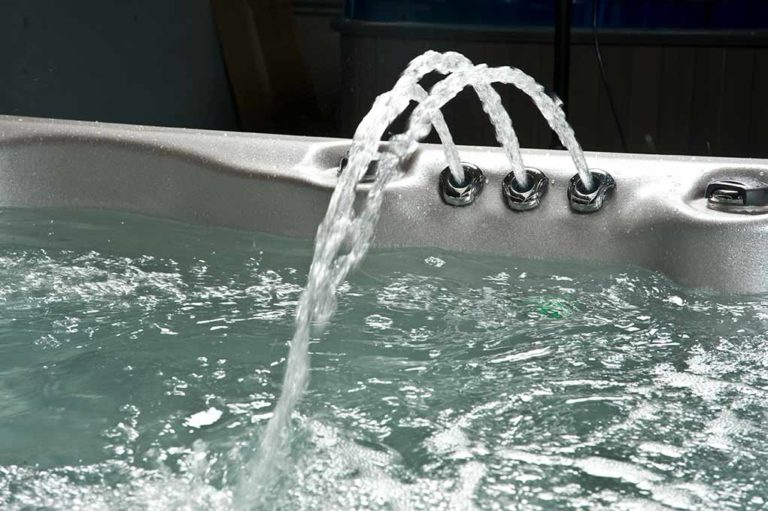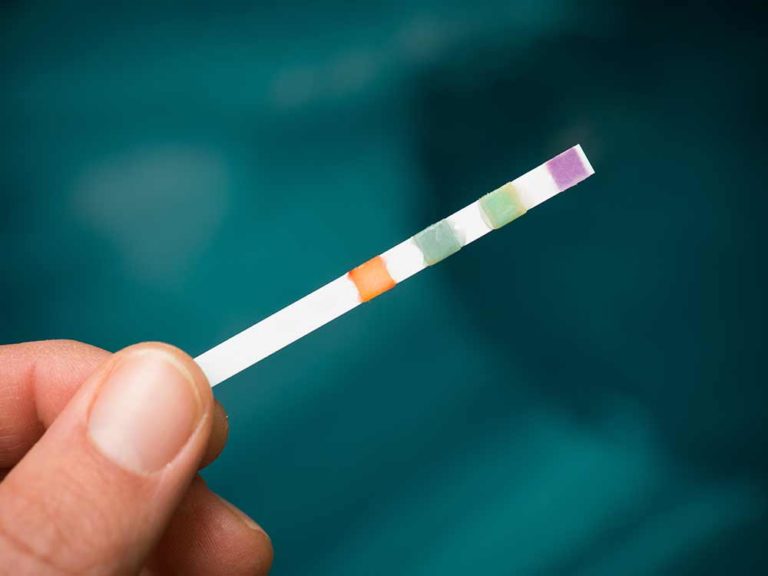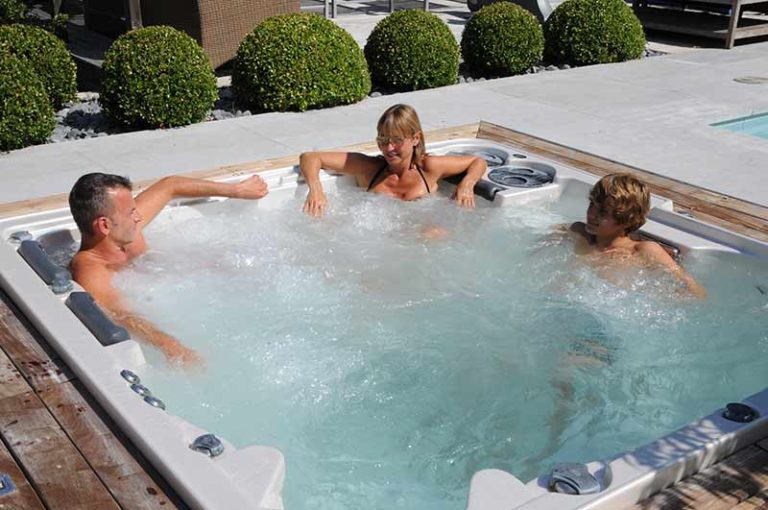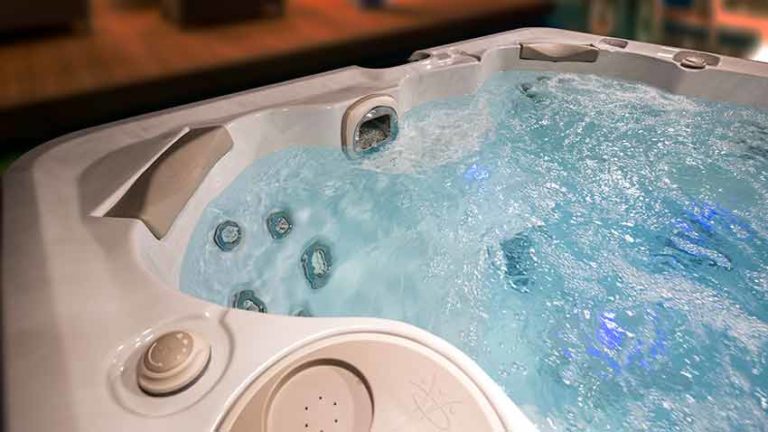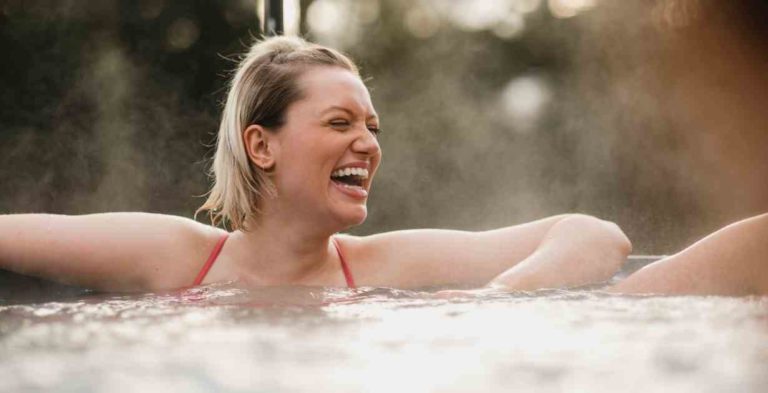Water Conservation in Pools and Spas: A Sustainable Approach
Water conservation is increasingly becoming a pivotal aspect of environmental sustainability, particularly in the recreational water market.
With the stark warning in 2019 from the CEO of the UK Environment Agency that we need to avoid “the jaws of death” by acting today to ensure enough water in 2050, it is clear that every drop counts.
This post delves into various facets of water management in swimming pools, hot tubs, and similar recreational water systems, highlighting the significance of conserving water at each step.
Water Testing: The Foundation of Water Conservation
Proactive Daily Water Testing
Proactive water testing for swimming pools and hot tubs is a critical step towards sustainable water conservation. This daily discipline is essential for detecting chemical imbalances early, which helps prevent the need for large-scale water replacements—a process that can be highly wasteful.
Accurate water testing is foundational. Pool owners and operators should employ reliable test kits and ensure they are calibrated to provide accurate results. Missteps in measurement can lead to unnecessary water treatments, resulting in substantial water loss. It’s not just about the tools, though; understanding the subtle nuances of the pool’s ecosystem is crucial. Daily test results can reveal trends and help anticipate the pool’s needs, promoting water conservation through informed decision-making.
Proper training is paramount for those conducting the tests. A firm grasp of the procedures ensures that the daily testing is a potent tool in maintaining water balance and not merely a routine task. Moreover, meticulous documentation of test results is essential for tracking water quality over time, making proactive testing a cornerstone of effective water management and conservation.
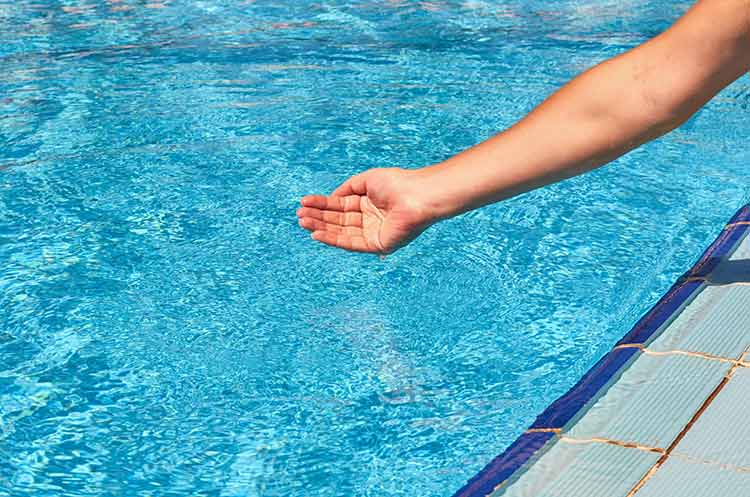

Accuracy in Water Testing: Choosing the Right Test Kit
Selecting the proper test kit is essential for water conservation in recreational facilities. Accuracy in water testing hinges on the quality and appropriateness of the test kits used.
Pool and spa operators and owners should opt for kits that are renowned for their precision, as even minor discrepancies can lead to excessive chemical use or water replacement.
Test kits come in various forms, from traditional comparator reagents and test strips to sophisticated digital photometers. Each type has its merits, but the key is to choose a kit that not only suits the specific needs of the facility but also delivers consistent accuracy. For instance, digital photometers can provide rapid and precise measurements, which are crucial for maintaining water quality without the guesswork that can lead to water wastage.
Regular calibration and maintenance of test equipment are as important as the initial selection. Over time, reagents can degrade, and electronic sensors can drift, leading to false readings. Pool operators must establish a schedule for checking the accuracy of their kits against known standards and replace any components as necessary.
In essence, the right test kit is a vital investment in water conservation efforts. By ensuring accurate water testing, facilities can avoid the unnecessary draining and refilling of pools, thereby saving water and protecting this critical resource.
Water Balance: A Delicate Equilibrium
The Role of pH, Chlorine, and Bromine in Water Balance
The careful management of pH, chlorine, and bromine levels is crucial for maintaining water balance and ensuring the longevity of recreational water resources. The pH level of water is a critical factor that influences the effectiveness of chlorine sanitisers, one of the primary disinfectants used in pools and spas.
If pH levels are too high, chlorine disinfectants can lose their efficacy, leading to the growth of bacteria and algae, which can necessitate a complete water change—a substantial water conservation concern.
Chlorine and bromine work by sanitising the water, neutralising harmful pathogens, and ensuring a safe swimming environment.
The performance of chlorine sanitisers (hypochlorous acid) is pH-dependent; chlorine works best in water with a pH between 6.8 – 7.4. Above this range, its ability to disinfect diminishes, potentially requiring more of the chemical to achieve the same level of sanitation, or in extreme cases, complete water replacement.
Maintaining the correct pH balance is not just adhering to health standards. It is also a significant aspect of water conservation strategy.
Regular testing and adjustments ensure that chlorine and bromine can perform their roles effectively. This minimises the need for excessive water treatment and preserves the quality of water without the need for frequent replacement.
This precise balancing act is a key to sustainable water management in the recreational water industry.
Combatting Biofilms in Pools
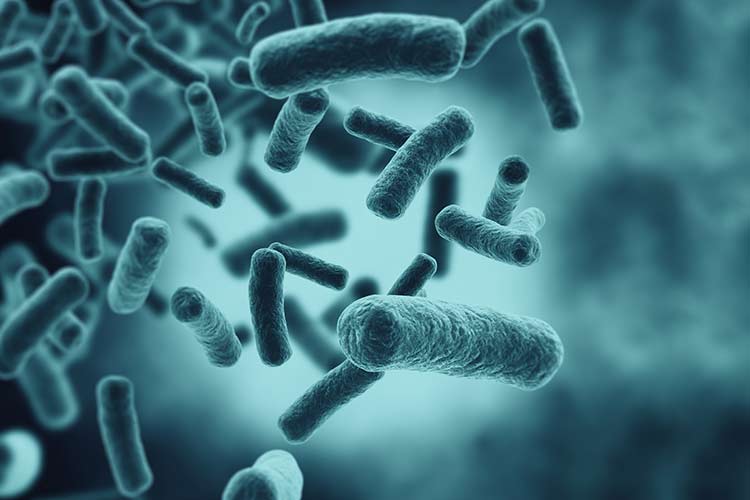

Biofilms pose a significant challenge in the recreational water market, presenting not only health risks but also impacting water conservation efforts.
These slimy layers that form on pool surfaces and in the plumbing systems are colonies of bacteria that can reduce the effectiveness of disinfectants, leading to increased chemical usage and potential water waste.
Combatting biofilms requires a proactive approach. Regular brushing and cleaning of pool surfaces disrupt the formation of biofilms, making it harder for bacteria to take hold.
This physical removal is essential because once established, biofilms can be resistant to typical chlorine levels with some resorting to chlorine shock treatments that often lead to partial or complete water replacement.
In addition to physical cleaning, maintaining an appropriate disinfectant level is crucial. Chlorine, though commonly used, may not always penetrate biofilms effectively.
Alternative treatments and sanitisers like chlorine dioxide or specialised enzymes can be introduced to break down these resilient structures without necessitating an increase in chemicals usage or water turnover.
Preventing biofilm formation is key to conserving water in swimming pools. By ensuring regular maintenance and employing targeted treatments, the need for drastic measures like draining the pool can be minimised. In turn, this conservation of water supports environmental sustainability while ensuring a clean and safe recreational water environment.
The Benefits of Chlorine Dioxide
Chlorine dioxide presents itself as an innovative solution in the realm of water treatment within the recreational water market. Its benefits are particularly significant in terms of water conservation.
Unlike traditional chlorine, which can form by-products that may hasten a water change, chlorine dioxide is known for its efficacy in water disinfection without the formation of chlorinated by-products.
It acts as a potent biocide at concentrations much lower than chlorine, effectively eliminating bacteria, viruses, and protozoa. It even has the unique capability to destroy biofilms, which are notorious for harbouring pathogens and resisting standard chlorination.
Water systems treated with chlorine dioxide therefore require less frequent draining and refilling, conserving significant amounts of water.
Chlorine dioxide has a reduced reaction with organic matter, which translates to less organic by-product formation. This means a reduced need for additional chemicals that can unbalance the water system. This is beneficial for heavily used pools or those with high organic load, where water conservation becomes challenging due to the constant need for excellent water quality.
In summary, introducing chlorine dioxide into recreational water care routines offers a dual benefit: a high level of sanitation while supporting water conservation. Its use supports the sustainable management of water resources in maintaining recreational water facilities.
Managing Total Dissolved Solids (TDS)
Total Dissolved Solids (TDS) are a critical aspect of water quality in pools and spas, reflecting the concentration of dissolved substances in the water.
High TDS levels can create a hostile environment for swimmers, interfere with the efficiency of disinfectants. It can cause cloudiness or scaling, which can require the full or partial draining and refilling of pools, and significant water wastage.
Effective management of TDS is imperative for water conservation. Regular monitoring should ensure levels remain within acceptable limits, typically below 1500 parts per million for swimming pools .
As TDS levels rise due to the accumulation of swimmer waste, chemical residues, and other contaminants, they can diminish water clarity and disinfectant efficacy. This not only affects the swimmers’ comfort and safety but also pressures facility operators to replace water more frequently.
To manage TDS, pool operators should ensure the chemistries they use to treat the water minimise have an impact on TDS levels. A good pool maintenance regime, with regular cleaning and ensuring efficient filtration, can lessen the increase of TDS levels.
When TDS levels are kept in check, the need for extensive water replacement is reduced, supporting water conservation and sustainable pool management practices.
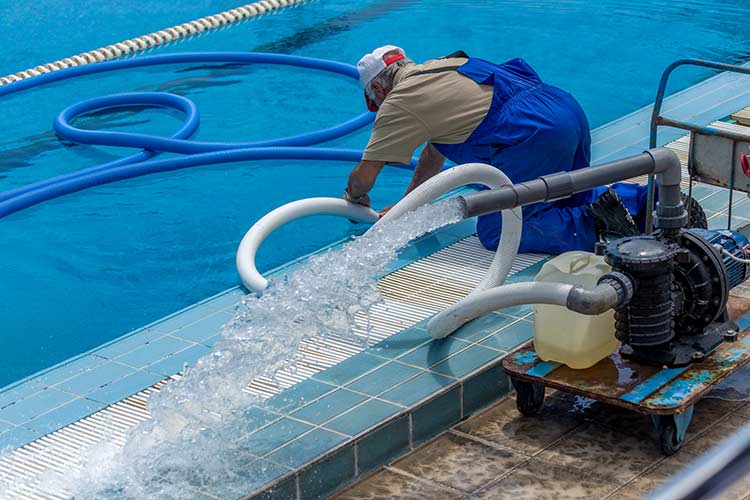

Filtration: The Heart of Water Purity
Clean Filters and Media
The filtration system in a recreational water setting is akin to the kidneys in the human body, playing a vital role in maintaining the health of the water.
Keeping filters clean and using the correct media are paramount for effective filtration, which directly correlates with water conservation.
A clean and appropriately sized filter operates more efficiently, reducing the need for frequent water replacement and chemical adjustments.
Filters trap debris and impurities, and over time, they can become clogged, leading to decreased water circulation and increased pressure within the system. This not only strains the equipment but also diminishes the effectiveness of the filtration process, potentially compromising water quality.
Adopting a good back-washing regime is essential; such as monitoring filter pressure differentials, length of backwash and media rinsing will ensure optimum performance and water conservation.
Periodic filter media inspection is necessary to maintain optimal function, but these processes must be balanced with water conservation efforts. Modern filter media such as glass tend to better results than traditional media.
Use the Right Size of Filter
Utilising the correct size and type of filter for the pool’s volume can significantly affect this balance. An undersized filter will require more frequent cleaning and potentially more water turnover. Conversely an oversized filter can handle higher loads with less maintenance.
The choice of filter media also plays a critical role. Options like sand, glass, cartridge or diatomaceous earth each have different filtering capabilities and maintenance requirements.
Selecting the right media can enhance the filter’s ability to remove smaller particles, improving water clarity and quality, and thereby reducing the need for draining and refilling the pool.
In essence, clean filters and the right choice of filter media and size are essential for efficient pool operations. They ensure the clarity and purity of the water, prolong the intervals between major water replacements. These factors contribute significantly to water conservation efforts.
Water Circulation: Keeping the Water Moving
Frequency and Turnover Rate
Effective water circulation is crucial for maintaining the health of recreational water bodies. The frequency of circulation and the pool’s turnover rate are pivotal factors that influence water quality and conservation.
Turnover rate is the time taken to filter the volume of water equivalent to the pool’s capacity. It a critical metric for determining the efficiency of water circulation.
A pool with a high turnover rate ensures that water is consistently moved through the filter.
A pool with a high turnover rate ensures that water is consistently moved through the filter. Debris and contaminants are removed, and an even distribution of chemicals is maintained. Frequent circulation prevents dead spots where algae and bacteria thrive, thus reducing additional chemical treatments and water replacement.
Debris and contaminants are removed and an even distribution of chemicals is maintained. Frequent circulation prevents dead spots where algae and bacteria thrive, lessening the need for additional chemical treatments and water replacement.
Inadequate circulation can lead to areas of stagnant water, promoting the growth of biofilms and other contaminants. This would then require more aggressive water treatment measures.
For optimal water conservation, the circulation system should be run as frequently as necessary. This maintains water clarity and sanitation, without being excessive. The correct frequency will depend on factors such as pool size, bather load, and the capacity of the filtration system.
Operators must balance the energy costs of running pumps with the conservation benefits of maintaining clean water to determine the ideal turnover rate. Some modern circulation pumps employ a variable speed drive.
By optimising the frequency and turnover rate of the pool circulation, water usage can be minimised, contributing to a more sustainable and environmentally friendly operation.
The Impact of Cyanuric Acid (Chlorine Stabiliser)
Cyanuric acid plays a pivotal role in the maintenance of outdoor pools, acting as a stabiliser for chlorine. It prevents rapid degradation under the sun’s ultraviolet rays. Its proper management is key to the effectiveness of chlorine and, subsequently, to water conservation efforts.
Maintaining the ideal cyanuric acid level allows for the optimal use of chlorine. The disinfectant therefore remains active longer and reduces the frequency of water treatment applications.
Balance is, however, a delicate issue.
While cyanuric acid is beneficial in small quantities, high levels can lead to what’s known as chlorine lock, where the presence of too much stabiliser reduces the efficacy of free chlorine. This can pose a significant problem, as the conclusion can be that more chlorine is needed, resulting in over-stabilisation and reduced disinfection.
To correct this issue, water may need to be diluted or even replaced, leading to water wastage.
The ideal concentration of cyanuric acid in a pool should be between 25 and 50 parts per million (ppm). Regular testing and careful consideration of sanitisers that add to cyanuric acid levels are essential practices to avoid the negative impact of over-stabilisation.
By keeping cyanuric acid within the recommended range, the pool’s chlorine will work more efficiently, reducing the need for excess chemical use and conserving water by extending the time between necessary water replacements.
When cyanuric acids are too high, water dilution is often the only realistic solution resulting is wasteful disposal of water and the costly replacement with fresh water.
The Crucial Influence of pH
The significance of pH in pool maintenance cannot be understated, as it profoundly affects both water quality and conservation.
A pool’s pH level is the measure of how acidic or alkaline (basic) the water is, with a range of 6.8 to 7.4 being ideal for most recreational water environments.
This delicate balance is crucial for the optimal performance of disinfectants and for the comfort of swimmers.
When using chlorine as a primary sanitiser a pH reading of 7.0 will see chlorine efficiency in the region of 70%. However a pH reading at 7.5 lowers the chlorine efficiency to around 45%. An even higher pH reading of 8.0 will see chlorine efficiency drop to around 20%.
This demonstrates the crucial influence of pH and how much more efficiently chlorine will work at a lower pH.
When pH levels stray from the ideal range, it can have a domino effect on water conservation efforts.
Low pH can lead to corrosive water, damaging pool components and necessitating the addition of more chemicals to correct the imbalance.
High pH can cause scaling, cloudiness, and reduced sanitiser efficacy, potentially leading to the need for increased chemical dosing and more frequent water replacement to restore clarity and balance.
Regular (daily) water testing, monitoring and adjustment of pH are therefore vital to maintaining a sustainable water system. It is a balancing act that requires precise interventions, ensuring that chlorine and other chemicals work effectively without the need for excessive application.
By keeping pH levels in check, not only is the structural integrity of the pool safeguarded, but the water itself can be conserved, reducing the environmental footprint of recreational water facilities.
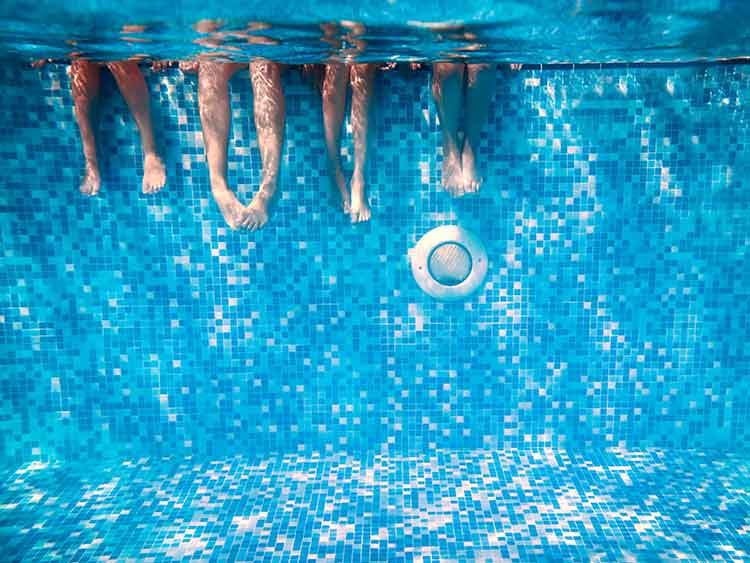

Encouraging Responsible Bather Behaviour
Shower Before Swimming
Showering before entering a pool is a simple yet effective measure that can have a substantial effect on water quality and conservation.
Encouraging bathers to take a brief 30 second shower without using soaps can remove up to 60% of the sweat, oils, cosmetics, and other organic matter that often end up in the pool water.
When these contaminants are introduced into the pool, they interact with chlorine to form chloramines, which not only cause the notorious ‘chlorine smell’ and can irritate eyes and skin but also reduce the efficiency of chlorine as a disinfectant.
The reduction of contaminants via pre-swim showers means that less chlorine is required to maintain the correct sanitation levels. This reduces the formation of chloramines and other disinfection by-products. Frequent water replacement and additional chemical treatments can be needed as a result, both of which are counterproductive to water conservation efforts.
Facilities that promote and facilitate pre-swim showering have a positive impact on the maintenance of water quality. By installing accessible shower facilities and encouraging their use, pool and spa venues can enhance the efficacy of their water treatment systems and reduce the frequency of draining and refilling pools.
This practice is therefore a straightforward yet impactful method for conserving water in the recreational water market.
The “Don’t Pee in the Pool” Rule
The directive to refrain from urinating in the pool is more than just a common courtesy; it’s an essential rule for maintaining water health and supporting conservation efforts.
Urine, being high in nitrogen and ammonia compounds, reacts with chlorine pool disinfectants to form chloramines, which not only have a strong odor but also irritate swimmers’ eyes and skin.
This reaction reduces the effectiveness of chlorine, requiring additional chemicals to maintain sanitary conditions and if, left unchecked, can lead to excessive water use and refilling of the pool. Both actions counteract water conservation.
The education of swimmers on the consequences of urinating in the pool is very important.
Communicating not just the “don’t” but the “why” is vital, outlining the chemical reactions that occur and how they impact water quality and conservation. Signage and regular announcements are useful reminders.
Moreover, the presence of chloramines in the water can signal to operators that the disinfectant is being used up in the reaction with contaminants rather than sanitising the water. This will prompt an unnecessary increase in chlorine dosing.
By preventing urine in the pool the health and comfort of swimmers is enhanced. In addition the water remains cleaner and requires less chemical treatment, reducing water wastage in recreational water venues.
Repurposing Water: Backwashing and Beyond
Repurposing water from recreational water systems like swimming pools, especially during backwashing of filters, is often an overlooked opportunity for significant water conservation.
Backwashing is a necessary process to clean the filter media. It can result in a considerable amount of water being wasted. Instead of allowing this water to be expelled, it can be captured and reused, aligning with sustainable water management practices.
The water from backwashing, although not suitable for drinking, can still be utilised in several ways. For instance, it can be used for irrigation in gardens and landscapes.
This water typically contains chemicals like chlorine, so it’s essential to dechlorinate it so it doesn’t harm plant life. This can be achieved through natural dechlorination by storing the water for briefly before use, allowing the chlorine to dissipate.
Test the water for free chlorine before secondary / repurposed use.
Additional Ways to Reuse Water
Repurposed backwash water can also be used to wash down pool decks, walk ways, outdoor furniture and flush toilets. This practice not only conserves fresh water but also reduces the operational water usage costs..
Introducing water-saving strategies such as water-saving devices for backwashing pre-filtration treatments (removal of larger debris) can reduce the volume of water used in the first place.
Pool operators can also consider upgrading to more water-efficient filters which require less frequent backwashing. Systems can also auto-adjust backwashing cycles based on the actual degree of filter media clogging, thereby optimising water use.
Furthermore, rainwater harvesting systems can supplement water conservation efforts by providing an additional source of water for pool top-up, further decreasing the demand on municipal water supplies.
By integrating such systems, facilities can significantly reduce their environmental footprint, conserve water, and set a precedent for responsible water usage in the recreational water market.
The practice of repurposing water from pool maintenance activities, coupled with efficient water management systems, is a testament to innovation. These strategies can be employed to ensure the sustainability of water resources in the face of growing environmental concerns.
Embracing Water Harvesting
Water harvesting stands as a beacon of sustainability in the fight for water conservation within the recreational water market.
By collecting and utilising rainwater, facilities can reduce their reliance on municipal water supplies. This is both cost-effective and environmentally responsible.
Embracing water harvesting involves the implementation of systems designed to capture, store, and treat rainwater. This water can then be used in swimming pools and spas.
The process begins with installing catchment areas, such as rooftops or specially constructed surfaces, which funnel rainwater into storage tanks. Such systems can be designed to accommodate the demands of the facility, ensuring a supply of water for pool top-ups.
It’s crucial, however, to treat this harvested water to ensure it is of pool water quality. This typically involves filtration and disinfection processes.
Beyond just pool top-ups, harvested water can be utilised for landscape irrigation, cleaning, and other non-potable purposes within the facility, maximising the utility of every drop collected.
By reducing the draw on conventional water sources, water harvesting also alleviates the strain on local water infrastructure, especially during peak summer months when water demand is at its highest.
Water harvesting systems can also serve as educational tools, demonstrating to patrons and the broader community the practical steps that can be taken toward sustainable water management. They can also contribute to a facility’s green credentials, which can enhance its public image and attract environmentally conscious customers.
The implementation of water harvesting is not without its challenges, including initial costs, space requirements for storage, and ongoing maintenance. However, the long-term benefits, both environmental and economic, can be substantial.
By investing in such systems, recreational water facilities position themselves as leaders in sustainability, actively contributing to the conservation of precious water resources in the face of increasing environmental challenges.
Conclusion
In the recreational water market, water conservation should be at the forefront of every operation.
By understanding and implementing these water management strategies, we can ensure the sustainability of our precious water resources while still enjoying the leisure activities we love. It’s not just about adhering to regulations or saving costs; it’s about safeguarding our environment for future generations.
Let’s make every drop count.

